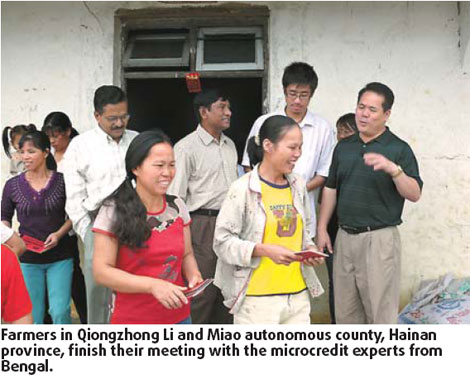


In March this year, the Hainan Rural Credit Union (HRCU) rented a four-floor hotel in Qiongzhong county of Hainan province for five years.
One month later, two microcredit experts from Bengal's Grameen Trust and seven Chinese men moved into the hotel and kicked off China's first official microcredit program based on the Grameen Bank model.
Based on an agreement signed last December, HRCU is now responsible for raising 30 million yuan to develop the microcredit program in Qiongzhong.
"Since the 1970s, the microcredit programs under the model of Grameen Bank have been successfully implemented in 94 countries all over the world. Based on the experience, the project in Hainan province is likely to make a profit in three years," says Wu Qiong, deputy manager of the microcredit department at HRCU Qiongzhong Branch.
Founded in 1976, the Grameen Bank in Bengal has targeted the country's poorest farmers and the bank's founder Muhammad Yunus won the Nobel Peace Prize in 2006 for the small loan program that helped 4 million people escape poverty.
Hainan province is China's only agriculture-oriented special economic zone and Qiongzhong is one of the poorest counties in the province.
In Hainan, one third of total production value is from agriculture and about 60 percent of the local residents are farmers, making it ideal to develop microcredit programs for poor people without access to financial services.
Md Haider Ali and Kalidas Banik, brought the Grameen Bank model from Bengal to Qiongzhong county; a model that includes loans for women, no mortgage loans, no co-signers and repayments every two weeks.
To their surprise, the Bengali measures have developed well in Qiongzhong county with few changes. The first batch of loans was successfully delivered in June, just two months after the program began.
"The development space is really amazing," says Ali. "In other countries, the first batch of loans is usually delivered after a six-month operation."
The initial microcredit loans are targeting the women in rural Qiongzhong county. The basic organization unit is a team, composed of five to 10 farmers, and five to 10 teams in one center. The team leaders and center directors are selected from the farmers, which will help the HRCU staff with daily management.
The farmers can usually get loans within seven to 10 days after applying for amounts ranging from 2,000 to 4,000 yuan. Usually, each farmer can be loaned 2,000 yuan each year, with annual interest rate of 10 percent. Loan payments are made every two weeks with a set amount of 84 yuan.
"By the end of September, our microcredit projects have loaned 116,000 yuan to 54 farmers in Qiongzhong county, which is used mainly to feed pigs, chicken and for some sideline economies," says Wu.
According to Wu, the local governments are quite supportive of the program, enough so that they pay half of each loan's interest. So the actual annual interest rate for the farmers is just 5 percent.
"So far, the repayment rate is 100 percent, without any defaults. Our goal is to lend 5 million yuan in microcredit during the first year. Based on estimates, the program can make a profit after the loans reach 20 million yuan," Wu adds.
But there are still some difficulties.
"Most Chinese farmers are used to repaying money in one sum and bothered about making 25 payments in a year. Since the program is still in its initial phase, it's not a piece of cake to make the farmers familiar with the loan model of Grameen Bank and have them accept it," says Wu.
For Wu and his colleagues, their daily schedules entail visiting one or two villages to promote the Grameen Bank model, educate the farmers and collect loan payments.
Currently, the pilot project is identical to the Grameen Bank model, except the microcredit companies are not allowed to take deposits.
"Without deposits, the microcredit sector in China is like using one leg to walk. And without them it's also hard to get farmers used to the habit of making regular deposits," says Ali.
Du Xiaoshan, deputy director of the Rural Development Institute of Chinese Academy of Social Sciences, says: "To some extent, the pilot unit in Hainan province is buying its technique from Grameen Bank. Its biggest advantage is the support it gets from the local government. With the 30 million yuan injected by Hainan Rural Credit Union, the microcredit projects can operate effectively."
According to Du, Nobel Laureate Yunus is also selecting counties in Sichuan province and Inner Mongolia to run other microcredit programs managed by Grameen Trust under the BOT (build-operate-transfer) scheme. Grameen Trust will establish the businesses and manage them for about five years and then hand over the projects to local governments.
In August, France's Groupe Danone announced it was investing 70 million yuan to establish a microcredit fund, which will be operated by the Grameen Trust for loans to farmers in the quake-hit areas of Sichuan province.
Bai Chengyu, division director with China International Center for Economic Technique Exchange and the secretary general for China Association of Microfinance, says: "In July, Professor Yunus wrote a personal letter to the governor of Sichuan province to express condolences. In this letter, he showed strong willingness to establish microcredit companies in Sichuan to support reconstruction."
"Now, the two parties are negotiating the details of the project and the first pilot unit is likely to be located in Aba Tibetan autonomous prefecture," Bai adds.
(China Daily 10/06/2008 page3)













